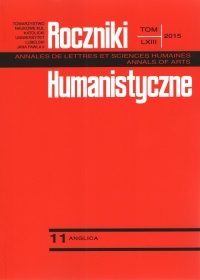“I came a long way to get here”: Narrative point of view, the trope of the journey and recontextualization in Kaye Gibbons’s Ellen Foster and its cinematic adaptation
Abstract
The main theoretical aim of this article is to analyze the ways in which the narrative discourse and thematic concerns of Kaye Gibbons’s best-selling novel Ellen Foster (1987), the literary original, are creatively re-worked in a different medium—its cinematic adaptation, the Hallmark Hall of Fame film. Therefore, I seek to show how the narrative point of view of the novel Ellen Foster is transcoded to the film of the same name, and to what degree the thematic concerns of the literary precursor find their way into a different medium. I will also analyze the final words uttered by the narrator within the rhetoric and narrative logic of both media to see whether they are consistent with the cultural discourse the texts are engaged in.
References
Abel, Elizabeth. “(E)Merging Identities: The Dynamics of Female Friendship in Contemporary Fiction by Women,'' Signs: Journal of Women in Culture and Society 6.3 (1981): 413-35.
Bordwell, David. Narration in the Fiction Film. Madison, Wisconsin: The University of Wisconsin Press, 1985.
Casetti, Francesco. “Adaptation and Mis-Adaptations: Film, Literature, and Social Discourses.” A Companion to Literature and Film. Ed. Robert Stam and Alessandra Raengo. Oxford: Blackwell Publishing, 2008. 81-91.
DeMarr, Mary Jean. Kaye Gibbons: A Critical Companion. Westport, Connecticut: Greenwood Press, 2003.
Ellen Foster. Dir. John Erman. Perf. Glynnis O’Connor, Jena Malone, Julie Harris, and Debra Monk 1997. Hallmark Hall of Fame.
Genette, Gérard. Narrative Discourse: An Essay in Method. Ithaca, New York: Cornell University Press, 1980.
Gibbons, Kaye. Ellen Foster. New York: Vintage, 1987.
Groover, Kristina. “Re-visioning the Wilderness: Adventures of Huckleberry Finn and Ellen Foster.” Southern Quarterly 37.3/4 (Spring/Summer 1999): 187–97.
The Hallmark Hall of Fame. http://www.hallmark.com/online/hall-of-fame/ Date of access: 10 May 2015.
hooks, bell. Where We Stand: Class Matters. New York: Routledge, 2000.
McFarlane, Brian. Novel to Film. An Introduction to the Theory of Adaptation. Oxford: Clarendon Press, 1996.
Monaco, James. How to Read a Film. New York: Oxford University Press, 1981.
Newitz, Annalee and Mathew Wray. “What is ‘White Trash’? Stereotypes and Economic Conditions of Poor Whites in the United States.” Whiteness: a Critical Reader. Ed. Mike Hill. New York: New York University Press, 1997. 168–84.
Penley, Constance. “Crackers and Whackers: The White Trashing of Porn.” White Trash: Race and Class in America. Ed. Newitz Annalee and Matt Wray. London: Routledge, 1996.
Powell, Dannye Romine. Parting the Curtains: Interviews with Southern Writers. Winston-Salem, NC: John F. Blair Publisher, 1994.
Reames, Kelly Lynch. Women and Race in Contemporary U.S. Writing. From Faulkner to Morrison. New York: Palgrave MacMillan, 2007.
Reed, John Shelton. Southern Folk, Plain and Fancy: Native White Social Types. Athens: University of Georgia Press, 1988.
Snodgrass, Mary Ellen. Kaye Gibbons: a Literary Companion. Jefferson, N.C.: McFarland, 2007.
Stam, Robert, Robert Burgoyne and Sandy Flitterman-Lewis. New Vocabularies in Film Semiotics. Structuralism, Post-structuralism and Beyond. London: Routledge, 1992.
Wagner, Geoffrey. The Novel and the Cinema. Rutherford, NJ: Fairleigh Dickinson University Press, 1975.
Wray, Matt. Not Quite White: White Trash and the Boundaries of Whiteness. Durham: Duke University Press, 2006.
Copyright (c) 2015 Roczniki Humanistyczne

This work is licensed under a Creative Commons Attribution-NonCommercial-NoDerivatives 4.0 International License.





